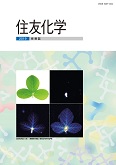FY 2019
2019.7.31 issue
-
Sumitomo Chemical Co., Ltd. has developed a propylene oxide (PO)-only manufacturing process where cumene acts as the oxygen carrier, which has a high reputation as a production method that offers distinct advantages of a high PO yield and superior stability in plant operation. In this article we outline the trends in PO manufacturing technology, and also introduce the status of licensing activities and features of the Sumitomo Chemical process.
(by Tomonori KAWABATA, Jun YAMAMOTO, Hirofumi KOIKE, Shuhei YOSHIDA)
-
Momfluorothrin is an exciting novel pyrethroid discovered by Sumitomo Chemical Co., Ltd. Momfluorothrin exhibited excellent knockdown activity which is approximately 20-fold higher (KT50 (min)) against house flies and approximately 30-fold higher (KT50 (min)) against German cockroaches than that of Tetramethrin in aerosol formulation. In addition to this extremely high knockdown activity, it has excellent performance (freezing effect) that knocked-down insects are promptly immobilized, which other pyrethroids have not ever had. Momfluorothrin is expected to become one of our key products as a new knockdown agent for aerosol. This paper describes the discovery story, physical properties, stability, insecticidal efficacies, synthetic method and safety evaluations of Momfluorothrin.
(by Tatsuya MORI, Jun OSHITA, Masahiro YAMADA, Yoshito TANAKA, Masaji HIROTA, Kaori MIYATA, Miho TABUCHI)
-
Skin sensitization caused by chemicals is one of the high social interest diseases in terms of maintenance and control of working environments and general consumer safety. In recent years, there have been strong demands to replace animal testing with non-animal testing to detect the skin sensitizing potential of chemicals. Several non-animal tests have already been developed and are being used for regulation of each country. In this review, we provide an overview of skin sensitization, and introduce international regulatory trends, new non-animal tests,
and our approach and future perspectives to the evaluation of skin sensitizing potential.
(by Hidenori SUTO, Tamaki HIGAKI, Saki KITANO, Yu OKUDA, Nobuyuki HORIE, Takafumi YAMAGUCHI)
-
To establish a single market in the European Union (EU), Council Directive 91/414/EEC concerning the placing of plant protection products on the market, and Directive 98/8/EC of the European Parliament and of the Council concerning the placing of biocidal products on the market, were adopted and harmonized Community provisions for pesticides and for biocides were achieved. The above-mentioned Directives were replaced by Regulation (EC) No 1107/2009 of the European Parliament and of the Council concerning placing plant protection products on the market, and Regulation (EU) No 528/2012 of the European Parliament and of the Council concerning the making available on the market and use of biocidal products, respectively. In this article, the changes in the procedures and the approval criteria for active substances which may be used in plant protection products or in biocidal products are summarized.
(by Hiroko HARADA, Mio TATSU, Mika OTA)
-
The emergence and spread of antimicrobial drug-resistant bacteria has become a global problem. Thus, urgent measures are being called for both at national and international levels. The Kitasato Institute and Sumitomo Dainippon Pharma Co., Ltd. are aiming to provide groundbreaking anti-infective drugs through unprecedented and original approaches, under the KS-Project joint drug discovery research. This paper describes the global problem of antimicrobial drug-resistant bacteria and our antimicrobial drug discovery project covered by the CiCLE.
(by Jun HIDAKA, Koji TAKEMOTO, Isao SHIMIZU)
